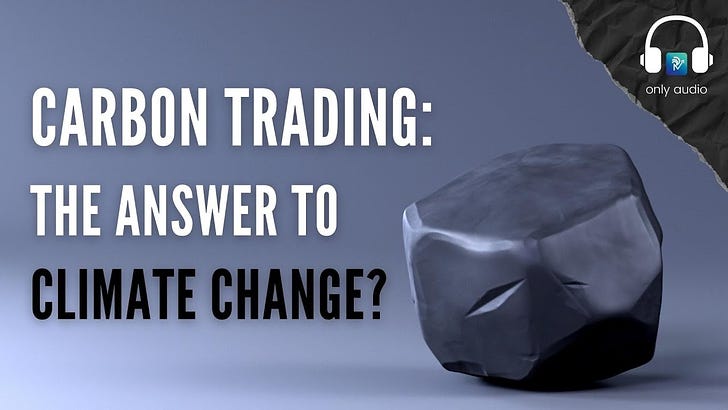🌡 Carbon Trading: The Answer to Climate Change?
Carbon trading is the new trend taking over the world. Here's why many think it will solve climate change.
The whole world seems to be revolving around two Cs lately: Coronavirus and Climate Change. And while we're fighting Covid with vaccines and masks, the fight against climate change is way more complicated. There is years of damage that needs to be undone.
And for that, the entire world needs to be on the same page. A behaviour that can only be driven by innovative incentives.
Enter: An elaborate carbon trading system.
What is Carbon Trading?
The year is 1997. Leaders of countries from across the world have gathered in Kyoto, Japan. They lay out a plan for controlling the increasing greenhouse emissions. And here the idea of carbon trading is born.
You see, the leaders realised the world would not simply change its ways. They would have to incentivise or punish the major polluting companies to drive the change. How could they do this?
Through carbon trading.
The government of a country usually sets a limit on the number of emissions a company can produce. Let's assume this limit is 100,000 tonnes.
Now, Company A produced only 80,000 tonnes of emissions, while Company B produced 120,000 tonnes of emissions. In this scenario, Company B can buy the permission to produce the extra 20,000 tonnes of emissions from Company A.
So, even though Company B didn't actually reduce its emissions in reality, on paper it has met the goal. But it had to pay a price for this. On the other hand, Company A gets rewarded with carbon credits which it can sell.
This is called the cap-and-trade model of carbon trading. The EU, China, Australia and several other countries have introduced this model. In this way, development is not compromised and climate goals are also met.
This carbon credit method is what has made Tesla profitable. The EV maker always has an excess of regulatory credits which it sells at a profit. Tesla made $518 million from these credits alone in the first quarter of 2021.
Some countries also levy a carbon tax on companies. The more a company pollutes, the higher the amount of the tax they have to pay. The method has worked for Sweden. It has reduced emissions by 25% since 1991, even though the country's economy grew by 60%.
But doesn't a combination of negative and positive reinforcements sound better? The reward will encourage more companies to do good. And so, most countries prefer the carbon credits method. The demand for carbon credits is growing, and the carbon offsets market is expected to be worth $100 billion by 2030.
While this sounds wonderful on paper, there has been a lot of confusion. The recent COP26 conference has solved some of these issues.
Around 200 countries have agreed to create a new and more efficient carbon trading framework.
New Carbon Trading Rules
The first issue is double counting. What's that?
For instance, India removed 10 tonnes of emissions from the atmosphere. So it gets 10 carbon credits. It sells these carbon credits to Pakistan. Now, because India produced the credits it wants to show this as its achievement in reducing emissions. But since Pakistan bought them, it wants these to be counted as its credits. What ends up happening is both countries claim they reduced 10 tonnes each, that is 20 tonnes total, when only 10 tonnes have been reduced from the environment.
This kind of double-counting makes it seem we have achieved impressive targets on paper, whereas the reality is much different. So, COP26 has agreed that the country that buys the credits will be able to claim the emissions reduction and not the country that produced the credits.
Furthermore, some credits will be deleted to make sure that more emissions are reduced from the atmosphere actively.
Also, 5% of the funds generated by the sale of carbon credits in the centralised market will go towards a climate fund, which will help developing nations fight global warming as well.
India's Emissions Trading System
So far, we've seen how the world is trading carbon credits. But now, let's zoom in a little closer and take a look at what is happening in our country.
India doesn't really have a developed carbon trading market like other major countries. However, we have several schemes that promote sustainability.
Like the Perform, Achieve, and Trade scheme, which was introduced in 2011, works like the cap-and-trade system but it only targets large industries that use a lot of energy.
The Indian government also requires all electricity distribution companies to produce a specific amount of electricity using renewable sources. The companies that do produce electricity using renewable energy are given renewable energy certificates, which work like carbon credits.
And now the government is also testing a full-fledged carbon trading market in Surat. The market will also be based on the cap-and-trade model. The pilot programme, which began in 2019, has already shown promise. It reduced particulate matter pollution by 24%.
Climate change, which threatens our entire existence in the future, is not motivating enough for us to mend our ways in the present. You see, we humans are not easily charmed by the idea of delayed gratification. So, the carbon credit system is driving action by shifting rewards from the future to the present. Can you think of any more innovative ways to drive this urgency in efforts?
Share this with your friends via WhatsApp or Twitter and help them become financially smarter! See you tomorrow :)
You can also listen to our stories because the Revolution ReadOn podcast is live!! Here: you can catch it on Spotify, Apple Podcast or Amazon Music, Google Podcasts, Gaana and Jio Saavn.
If you are coming here for the very first time: Don’t forget to join us on WhatsApp to get daily updates! 👇




Very easy to understand 👌👌